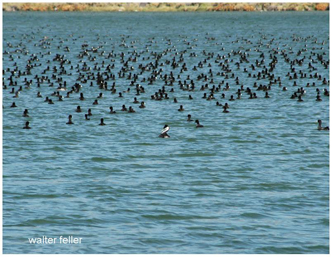American Coot
Fulica americanaFamily: Rallidae Order: Gruiformes Class: Aves

DISTRIBUTION, ABUNDANCE, AND SEASONALITY
The American coot is a common to abundant resident throughout most of the state below
2150 m (7100 ft). It is found in fresh, and saline emergent wetlands, wet grasslands,
pastures, lacustrine, estuarine, cropland, and urban habitats. Uncommon on bay tideflats and
salt marshes, except in winter months. May form huge concentrations at larger lakes, and at
the Salton Sea before heavy winter freezes (Cogswell 1977, Garrett and Dunn 1981).
SPECIFIC HABITAT REQUIREMENTS
Feeding: Forages underwater on the foliage and roots of submerged aquatic plants such
as filamentous algae, pondweeds, and watermilfoil (Fitzner et al. 1979). Also feeds by
gleaning seeds, insects, and small fish from water, soil and vegetation. Large groups may
feed along wetland edges, and in open fields.
Cover: Retreats to open water, or into dense wetland vegetation, when disturbed (Gullion
1953).
Reproduction: Nests over water in dense, emergent wetlands, preferably among
bulrushes or cattails. Often nests in rice croplands. Builds in succession, a display platform,
an egg nest, and a brood nest. Egg nest usually 0.6 to 0.9 m (2-3 ft) from open water (Bent
1926, Gullion 1954). Egg and brood nests are large, woven platforms usually placed on a
floating foundation of dry plants.
Water: No additional data found.
Pattern: Breeds primarily in dense, fresh emergent wetland. Requires permanent, or
semi-permanent, emergent vegetation, particularly cattails or bulrushes, and stable water
levels during the breeding season. May be found in autumn and winter in Salicornia and
Spartina associations with open water.
SPECIES LIFE HISTORY
Activity Patterns: Yearlong, diurnal activity.
Seasonal Movements/Migration: Population breeding in colder locations in the state
migrates in September and October to areas where water remains unfrozen. Inland
population may move to the coast for winter. Migratory patterns not well known.
Home Range: No data found.
Territory: Breeding territory in a California study averaged 0.43 ha (1.06 ac), and ranged
from 0.22 to 0.56 ha (0.54 to 1.39 ac) (Gullion 1953). Aggressively defends territory intraand
interspecifically (Ryder 1959, Ehrlich et al. 1988).
Reproduction: Monogamous; breeds April-September, with a peak May-June. First clutch
averages 9 eggs, and second clutch 6.4 eggs. Incubation period 23-24 days, by both sexes.
Precocial young tended by both parents (Gullion 1954, Fredrickson 1970). Young are
independent at 5 wk.
Niche: Raccoons, hawks, owls, and eagles are common predators. Hunted regularly, but
not highly prized.
REFERENCES
Bent, A. C. 1926. Life histories of North American marsh birds. U.S. Natl. Mus. Bull. 135.
490pp.
Cogswell, H. L. 1977. Water birds of California. Univ. California Press, Berkeley. 399pp.
Ehrlich, P. R., D. S. Dobkin, and D. Wheye. 1988. The birder's handbook. Simon and
Schuster, New York. 785pp.
Fitzner, R. E., E. T. Sipco, and R. G. Schrecknise. 1979. American coot nesting and feeding
habits in southeastern Washington. Northwest Sci. 54:244-252.
Fredrickson, L. H. 1970. Breeding biology of American coots in Iowa. Wilson Bull. 82:445-
457.
Garrett, K., and J. Dunn. 1981. Birds of southern California. Los Angeles Audubon Soc.
408pp.
Gullion, G. W. 1953. Territory behavior of the American coot. Condor 55:169-186.
Gullion, G. W. 1954. The reproductive cycle of American coots in California. Auk 71:366-
412.
Ryder, R. A. 1959. Interspecific intolerance of the American coot in Utah. Auk 76:424-442.
Valley has reduced available habitat; densest populations remain in hunting clubs, wildlife
areas, and along other managed water channels (Cogswell 1977).
Comments: Formerly called common gallinule (Cogswell 1977).
REFERENCES
Bent, A. C. 1926. Life histories of North American marsh birds. U.S. Natl. Mus. Bull. 135.
490pp.
Cogswell, H. L. 1977. Water birds of California. Univ. California Press, Berkeley. 399pp.
Dawson, W. L. 1923. The birds of California. 4 Vols. South Moulton Co., San Diego. 2121pp.
Eckert, A. W., and K. E. Karalus. 1981. The wading birds of North America. Doubleday and
Co., Garden City, NY. 252pp.
Fredrickson, L. H. 1971. Common gallinule: breeding biology and development. Auk
88:914-919.
Garrett, K., and J. Dunn. 1981. Birds of southern California. Los Angeles Audubon Soc.
408pp.
Grinnell, J., and A. H. Miller. 1944. The distribution of the birds of California. Pac. Coast
Avifauna No. 27. 608pp.
Gullion, G. W. 1953. Territory behavior of the American coot. Condor 55:169-186.
Harrison, C. 1978. A field guide to the nests, eggs and nestlings of North American birds.
W. Collins Sons and Co., Cleveland, OH. 416pp.
Harrison, C. J. O., ed. 1978. Bird families of the world. Harry N. Abrams, Inc., New York.
264pp.
Johnsgard, P. A. 1975a. North American game birds of upland and shoreline. Univ.
Nebraska Press, Lincoln. 183pp.
McCaskie, G., P. De Benedictis, R. Erickson, and J. Morlan. 1979. Birds of northern
California, an annotated field list. 2nd ed. Golden Gate Audubon Soc., Berkeley. 84pp.
Ripley, S. D. 1977. Rails of the world: Monograph of the family Rallidae. D. R. Godine,
Boston, MA. 406pp.
Terres, J. K. 1980. The Audubon Society encyclopedia of North American birds. A.
Knopf, New York. 1100pp.
California Department of Fish and Game. California Interagency
Wildlife Task Group. 2005. California Wildlife Habitat Relationships version 8.1 personal computer program. Sacramento, California.
Fulica americana
Adults have a short thick white bill and white frontal shield, with a reddish-brown spot near the base of the bill between the eyes. The body is grey with the head and neck darker than the rest of the body. Their legs are yellowish, with scalloped toes rather than webbed feet. Their chicks have black bodies with bright red head and beak, and orange plumes around the neck.
Their breeding habitat is marshes from southern Quebec to the Pacific coast of North America and as far south as northern South America. They nest in a well-concealed location in tall reeds. They are frequently seen swimming in open water.
These birds can dive for food but can also forage on land. They are omnivores, eating plant material, insects, fish, and other aquatic animals. Adults mostly consume "pond scum".

May retreat into open water when disturbed.